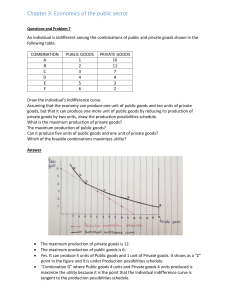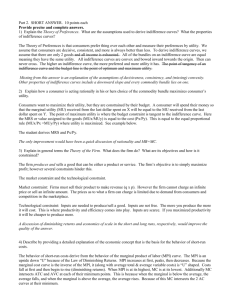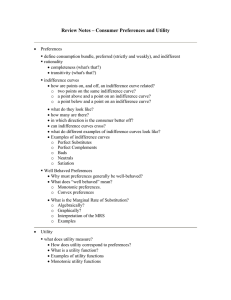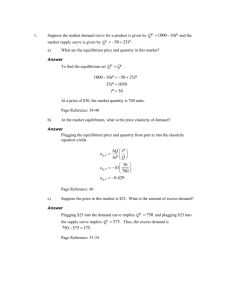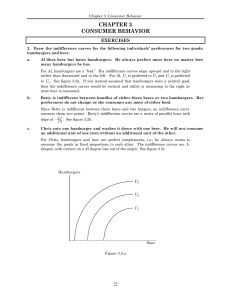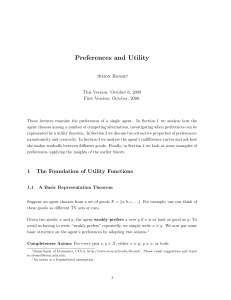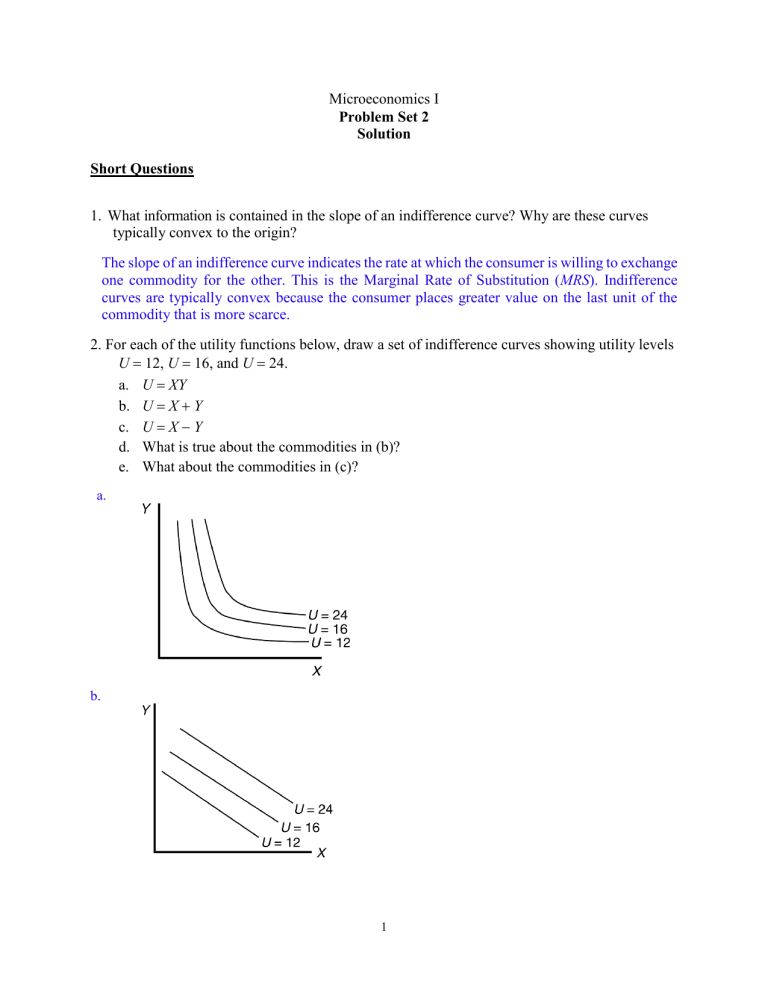
Microeconomics I Problem Set 2 Solution Short Questions 1. What information is contained in the slope of an indifference curve? Why are these curves typically convex to the origin? The slope of an indifference curve indicates the rate at which the consumer is willing to exchange one commodity for the other. This is the Marginal Rate of Substitution (MRS). Indifference curves are typically convex because the consumer places greater value on the last unit of the commodity that is more scarce. 2. For each of the utility functions below, draw a set of indifference curves showing utility levels U 12, U 16, and U 24. a. U XY b. U X Y c. U X Y d. What is true about the commodities in (b)? e. What about the commodities in (c)? a. b. 1 c. d. They are perfect substitutes. e. X is a good, and Y is a bad, providing exactly the opposite of X in utility per unit. 3. If we observe a consumer choosing (𝑥1 , 𝑥2 ) when (𝑦1 , 𝑦2 ) is also available, are we justified in concluding that (𝑥1 , 𝑥2 ) (𝑦1 , 𝑦2 )? No. It might be that the consumer was indifferent between the two bundles. All we are justified in concluding in that (𝑥1 , 𝑥2 ) ≿ (𝑦1 , 𝑦2 ). 4. If good 1 is a neuter, what is its marginal rate of substitution for good 2 (i.e. MRS of 1, in terms of 2)? Zero- if you take away some of good 1, the consumer needs zero units of good 2 to compensate him for his loss. 5. Which of the following are positive monotonic transformations of 𝑢: a) 𝑣 = 2𝑢 − 13 b) 𝑣 = −1/𝑢2 c) 𝑣 = 𝑙𝑛𝑢 for u>0 d) 𝑣 = 𝑢2 for 𝑢>0 𝑑𝑉 For the above to be positive monotonic transformations of u, 𝑑𝑈 > 0 a) b) c) d) Yes. No, only works for u positive. Yes. Yes. 6) Show that the utility functions V(X,Y) = XaY1-a and U(X,Y) = a ln(X) + (1-a)ln(Y) represent the same ordering of bundles. ln(V(X,Y)) = ln(XaY1-a) = ln(Xa) + ln(Y1-a) = U(X,Y) 2 Multiple Choice Questions 1) If two indifference curves were to intersect at a point, this would violate the assumption of A) transitivity. B) completeness. C) Both A and B above. D) None of the above. 2) Measuring "y" on the vertical axis and "x" on the horizontal axis, convexity of indifference curves imply that the MRS of "x" for "y" A) is decreasing as "x" increases. B) is increasing as "x" increases. C) is constant as "x" increases. D) cannot be calculated for large levels of "x". 3) If two goods are perfect substitutes, then the indifference curves for those two goods would be A) upward-sloping and concave to the origin. B) downward-sloping and convex to the origin. C) downward sloping and straight. D) L-shaped. 4) If the utility function (U) between food (F) and clothing (C) can be represented as U = the marginal utility of food equals A) . B) . C) 1/2 . D) 1/2 . 5) If two goods, "x" and "y", are perfect substitutes, then which of the following best represents the utility function for the two goods? A) U = x + y B) U = x ∗ y C) U = + D) U = x / y 6) Which of the following utility functions has the same MRS as U(q1,q2) = q1 q2? A) q11/2 q21/2 B) q1 + q2 C) q11/2 + q21/2 D) (q11/2 + q11/2)2 3 ,
